Atlas Cross Sport fills VW’s SUV niche
By John Gilbert
We were only a couple of days into our weeklong road test of the new 2020 Volkswagen Atlas Cross Sport when I turned south on 60th Avenue East from Superior Street toward London Road, and the Duluth gateway to the North Shore Drive. I was impressed by the Atlas, because pretty much everything is impressive with the SEL Premium model, and I hadn’t yet closely examined what makes the Cross Sport different from the garden-variety Atlas.
There is a hiking/biking trail that crosses 60th, just about 10 feet before you cross a set of railroad tracks. I was going about 20 miles per hour, no hurry, and not fast enough to give us any jolts from the railroad tracks.
Suddenly, there was a terrible noise and the Atlas Cross Sport lurched to a stop. Very sudden. Fortunately, I had experienced the same jolt in previous road tests, so I recovered my decorum right away. What it was, was what the VW information refers to as “forward collision detection and assist,” and this was definitely in the “assist” category. The finely discerning VW system with its radar, sonar, camera and computer system all coordinated, spotted the railroad tracks as a nasty enough hazard to help me decide that I shouldn’t just sail over it. It helped me decide by deciding for me, that I should be stopped, and then maybe creep over the hazard.
Pretty impressive safety item, particularly for objects you might not see in the road ahead, and it could prevent you from hitting somerhing you and your VW would be better off not hitting.
There are a lot of other neat features in the new Volkswagen Atlas Cross Sport, which is an intriguing look at what VW is thinking these days, but none of them makes a more abrupt impression.
Volkswagen came out with the Atlas a couple years ago, as a vehicle that sits taller than the Jetta or Passat, and is up there amid the segment already populated by VW’s two SUVs — the Tiguan and the Touareg — but which defies accurate description. Is it a wagon, or a bulky sedan, or a sleek SUV? The answer is: All of the above.
When you line up the Golf GTI, Jetta, Passat, Atlas, Tiguan and Touareg door-handle to door-handle, they all share the newly christened VW signature look, with their wide, sweeping grilles, blending stylishly into the headlight enclosures. Now add the Atlas Cross Sport, and you get yet another similar grille.
From the side, the Cross Sport looks sleek, because it has a nicely tapering rear roofline, with sloped-back rear pillars, where the Atlas itself is more upright. That tapering adds to style, but it also fools you into needing to look up the statistics. The Atlas is a pleasant, roomy vehicle with three-row seating capability, and a large amount of headroom. It sits well, meaning its body fits on its frame as though it belongs there. But VW realized a lot of people don’t need three rows of seats, and usually leave the third row folded down, and by squeezing in room for the third row, the second row legroom is tightened.
So engineers carved nearly 6 inches off the length of the Atlas, leaving the wheelbase the same, but taking it all off the front and rear overhangs. The Cross Sport length is 195.5 inches, but it suddenly finding more room available inside the shorter body. The second row seat is fixed into the floor, and it is set back from the normal Atlas, which means nearly 3 inches more legroom for rear-seat occupants.
Our son, Jack, noted that there was an amazing amount of legroom, as well as the headroom he had assumed would be there.
Performance wise, the Atlas Cross Sport has the same powertrains as the regular Atlas, which means a couple of venerable standards — the 2.0-liter 4-cylinder, which is among my favorite engines in the world when turbocharged into the GTI, and the 3.6-liter V6, which is unique among all V6 engines in the world, because it is designed to be narrow, with actually the cylinders interwoven in a serpentine manner. That allows streamlining in the valve train, and it turns out a lot of power without turbocharging.’
The test Atlas Cross Sport had the optional 3.6 V6 with its 4Motion all-wheel drive, and it delivers 276 horsepower with 266 foot-pounds of torque, good enough to accelerate strongly with its 8-speed Tiptronic transmission, or hitched up to tow 5,000 pounds of trailer weight.
Along with the forward collision assist, and the usual safety items, there is a hill-holding system and a hill descent control, plus park assist and lane-keeping assist A large, twin panel sunroof covers both rows of seats, and with a 15-way adjustable bucket seat, you can find a perfect driving position. Rain-sensing wipers, giant 20-inch wheels, and an 8-inch touchscreen for navigation and other audio and climate readouts.
A Fender Premium Sound system fills the cabin with sound, and the premium leather and appropriately soft-touch but durable feeling fabrics cover everything in the notably black interior. But those special little touches abound, too.
For example, whenever I get in a car, I lower the pillar anchor for the shoulder strap to its lowest possible position, simply because I believe you’re safer with a low-set harness compared to a higher one. Well, on the Cross Sport, VW has installed lower anchors and tethers for the harnesses, the better to keep children properly restrained.
The SEL Premium has everything upgraded inside and out, and even park assist and lane-keeping assist are standard, so there were no options on the sticker price, which sits at $48,095 after destination.
As usual with every vehicle VW makes, there is a sturdy, solid feel to the Atlas Cross Sport, and it rides smoothly and then turns with poised agility when you make a sharp turn. It also will twirl a u-turn in an amazingly small distance. Just watch out for railroad tracks!


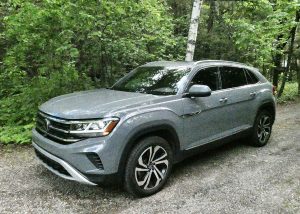
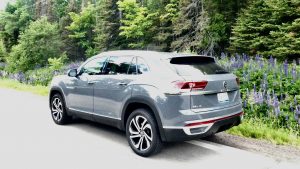
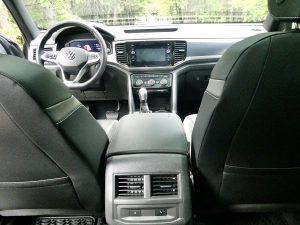
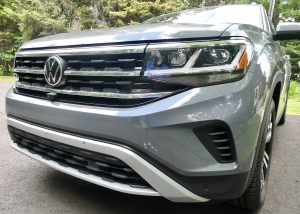
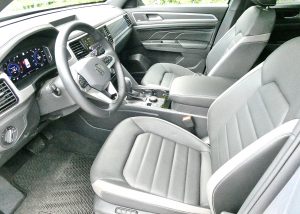
 John Gilbert is a lifetime Minnesotan and career journalist, specializing in cars and sports during and since spending 30 years at the Minneapolis Tribune, now the Star Tribune. More recently, he has continued translating the high-tech world of autos and sharing his passionate insights as a freelance writer/photographer/broadcaster. A member of the prestigious North American Car and Truck of the Year jury since 1993. John can be heard Monday-Friday from 9-11am on 610 KDAL(www.kdal610.com) on the "John Gilbert Show," and writes a column in the Duluth Reader.
John Gilbert is a lifetime Minnesotan and career journalist, specializing in cars and sports during and since spending 30 years at the Minneapolis Tribune, now the Star Tribune. More recently, he has continued translating the high-tech world of autos and sharing his passionate insights as a freelance writer/photographer/broadcaster. A member of the prestigious North American Car and Truck of the Year jury since 1993. John can be heard Monday-Friday from 9-11am on 610 KDAL(www.kdal610.com) on the "John Gilbert Show," and writes a column in the Duluth Reader.